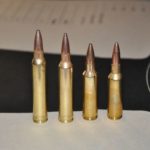
Where are the short-barreled magnums?
At the turn of the millennium, 13 years ago, the biggest news in the rifle world was the proliferation of new cartridges based on the old African hunting round named the .404 Jeffrey.
The Jeffrey is a particularly ‘fat’ cartridge, making it perfect for being shortened and producing the now ubiquitous ‘short/fat’ rounds that seem to have rooted themselves in the rifle cartridge aisles of your favorite big-box or smaller gun store.
The benefits of this new design were the stuff of legends-in-the-making.
The ‘short/fat’ powder column exposed more powder granules to the primer flash, resulting in more-even, quicker ignition. This supposedly made it perfect for improvements in accuracy.
The ‘fat’ powder column, with its increased efficiency of ‘burn’ gave more horsepower, thus more velocity, thus increased ballistic efficiency to any bullet it was pushing with less powder than the big magnums like the .300 Winchester Magnum and 7mm Remington Magnum.
In other words, the ‘short, fat’ concept worked, and EVERYBODY was inventing new rounds with the imaginative names ballistic wildcatters are famous for inventing.
Browning and Winchester collaborated, and produced the first commercially available standardized rifles and cartridges in the new design with the .300 WSM or Winchester Short Magnum.
The response was nothing short of phenomenal; people wanted the new cartridge that would reach out forever and hit the proverbial gnat with unerring accuracy never before seen.
Quick to recognize a good thing, and to maintain dominance in the new market, Winchester introduced a whole family of ‘short, fat’ cartridges with the 7mm WSM, then the .223 WSSM or Winchester Super Short Magnum (one of the homeliest cartridges ever invented — it gives the impression of being as wide as it is tall), and the .243 WSSM and .325 WSM.
Remington elected to wait a year and bet on their production of a super-long-range new magnum, their .300 Remington Ultra Magnum — a GREAT BIG cartridge that overcame the laws of physics by shooting a heavier bullet flatter out to 400 yards before it dropped like a stone. This cartridge was based on the .404 Jeffrey, also. Pour a pound of powder in it, touch the trigger and dynamite came out the end. Or so the urban legend ran.
So a year behind Browning/Winchester, Remington entered the market with their own ‘short, fat’ cartridge — shortening the case of their .300 Remington Ultra Magnum to come up with the Remington .300 SAUM or Short Action Ultra Magnum.
The .300 SAUM never caught up to the .300 WSM, but Remington chambers rifles in it and it remains a relatively popular cartridge in their line.
I have range tested a number of these new rounds in various Remington, Browning and Winchester rifles, and the best I can say about the supposed accuracy is — well ….
I have taken a brand-new Remington Model 700 bolt-action rifle in .300 Winchester Magnum (a particularly favorite cartridge), loaded it with 150 grain Remington Core-Lokt factory ammo and seen near ½-inch groups.
I have shot several of the new short, fat rounds in absolutely new Browning A-Bolt rifles, and the accuracy was only ho-hum.
While the ‘short/fat’ concept might offer a smidgen of accuracy improvement over the longer cartridges, it’s a crap shoot that YOUR rifle chambered in one of the new short magnums will shoot under minute-of-angle with any particular factory ammo. You generally have to tune your cartridge to your rifle.
To get the accuracy I described out of the .300 Win Mag Model 700 is a happy circumstance that is not often described with straight factory everything.
The short magnums are so ballistically close to the long magnums (consider the .300 WSM, the .300 SAUM, the 7MM Rem Mag and the .300 Win Mag) that they can all be considered in the same ‘family’ — the ballistic flight path of a 150-grain 7MM Rem Mag, a 150-grain .300 Win Mag and a 150-grain .300 WSM or .300 SAUM are all so close as to cancel one another out in usefulness.
The big difference, and the reason I bought my Remington Model 673 ‘Guide Gun,’ was the ability to get magnum performance out of a shorter barrel.
The 7MM Rem Mag, and to a lesser degree, the .300 Win Mag are ‘overbore.’ To get the maximum velocity available out of the powder charge, the barrels generally are 26 inches long so all the powder is burned and pushing the bullet by the time it leaves the barrel.
Thus, I was excited with the advent of these new cartridges because I saw a whole new family of shorter, more-manageable rifles being built and designed for these cartridges that would give magnum velocities out of shorter barrels.
Unfortunately, I never saw that trend follow the development of the new cartridges, and that’s disappointing.
It seems most of the rifles chambered for these rounds come in 24-inch length, but if the properties remain the same — and testing shows barrel length does not drastically change velocities when shortened an inch or 2 — then WHERE are all the 22-inch barrels I have been expecting.
My Guide Gun on a chronograph with 150-grain Remington Core-Lokts reaches a consistent velocity of nearly 3,100 feet per second. It produces minute-of-angle (1-inch) groups on the bench, is a pleasure to shoot, handles beautifully with its 22-inch barrel and does everything I ask it to do without getting in its own way with an extra 4 inches of barrel. And a 150-grain bullet at 3,100 fps is serious medication.
Zeroed at 200 yards, its 150-grain Core-Lokt drops 6.4 inches at 300 yards, according to a Remington ballistic chart. The chart says 3,200 FPS at the muzzle.
Zeroed at 200 yards, the .300 WSM with the same bullet drops 6.2 inches at 300 yards.
Zeroed at 200 yards, the .300 Win Mag drops 6.3 inches at 300 yards.
Zeroed at 200 yards, the 7mm Rem Mag with a 150-grain Core-Lokt drops 6.7 inches at 300 yards.
See what I mean? The difference between the cartridges is the large magnums eat about 10 grains more powder and require another 2 inches of barrel to get the efficiency out of the powder. Thus the short magnums ARE more efficient.
But once you get in the vicinity, fractions of an inch don’t matter at 300 yards.
Since my rifle produces 3,100 fps, why aren’t there more ‘short, fat’ magnums with 22-inch barrels out there? The shooting public has completely overlooked the most-valuable attribute of these great new cartridges.
The manufacturers respond to customer demand, and the customers are missing the bet — buying something that is a replication of existing cartridges, and buying longer, more-unwieldy, heavier barrels than they need.
Better we all get over the velocity fetish, learn where the rifle shoots at 200 and 300 yards, and spend more time on the sandbags — you’ll be a better shooter, better able to estimate distance and have the confidence in your rifle, whatever the barrel length, to make the longer shots and effect a clean, killing shot — the ultimate quest for every ethical rifleman.




